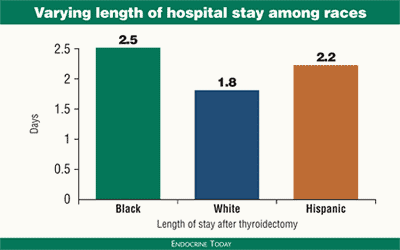Racism, ageism in endocrine surgery result in negative clinical, economic outcomes
Nonwhite and elderly patients had overall longer hospital stays and increased complications, mortality rates and hospital costs.
NEW YORK — Racism and ageism are ever-present in endocrine surgery, according to Julie Ann Sosa, MD.
“Thyroid nodules occur in 5% to 50% of Americans. And thyroid cancer is the fastest growing cancer in American women, up 240% in the last three decades,” said Sosa, assistant professor of surgery and clinical epidemiology at Yale School of Medicine.
Sosa studied race- and age-related differences in clinical and economic outcomes following thyroid procedures in the United States. Sosa presented these findings at the 78th Annual Meeting of the American Thyroid Association.
Does racism exist in surgery?
“Although thyroidectomy is considered by most of us to be a safe operation, significant racial disparities exist in clinical and economic outcomes,” she said.
The researchers analyzed a nationwide sample of 16,868 in-patient hospital discharges in 37 states between 1999 and 2004. Overall, total thyroidectomy was performed more often among whites — 43% — than among blacks and Hispanics, who tended to undergo subtotal thyroidectomy.
“Compared with whites, black and Hispanic patients have longer length of stay, higher total hospital costs and certainly a trend toward higher complication rates,” she said.
The differences persisted even after a multivariate analysis.
Rates of mortality were higher among black patients compared with patients of other races. Blacks also had higher overall complications (4.9%) compared with whites (3.8%) and Hispanic (3.6%).
Furthermore, these differences appear to be related to access to experienced surgeons, according to Sosa. More white patients were treated by high-volume surgeons compared with non-white patients. In 2000, 1% of white patients underwent thyroidectomy with a high-volume surgeon, which increased to 7% in 2004. Just 0.2% of black patients had a high-volume surgeon in 2000 compared with 1.8% in 2004. Hispanic patients had vritually no access to a high-volume surgeon in 2000 compared with 1.3% in 2004.
“It appears that although all racial groups are increasingly being referred away from the lowest-volume thyroid surgeons to surgeons who perform more of these procedures, the discrepancy in access between races has only widened over time,” she said.

Effects of ageism
“The proportion of elderly Americans has significantly increased during the last several decades, in particular those aged 80 or older who are now commonly referred to as the ‘super-elderly,’” Sosa said. “Given that the incidence of thyroid nodules increases with age, [this] will make the diagnosis and surgical treatment of thyroid disease an important health issue for elderly Americans.”
To gauge the extent of post-thyroidectomy outcomes among the elderly, Sosa and colleagues also analyzed 22,848 patients (18% aged 65 to 79; 3% aged >80) and used a method similar to the racism study.
Generally, the super-elderly fared worse with regard to all outcome measures, according to Sosa. Age proved to be an independent predictor of length of hospital stay, complications and total cost. The average post-thyroidectomy length of stay for a super-elderly patient was more than a day longer compared with a patient aged 65 or older and more than twice that compared with a patient aged 18 to 44.
Thyroidectomy costs for a super-elderly patient were 39% more compared with patients aged 65 to 79 years. Complication rates were slightly higher among the super-elderly. Mortality rates also increased in a step-wise fashion, Sosa said. Nearly one in 100 super elderly patients died following thyroid surgery.
The majority of thyroid surgeries in the elderly population were performed by low-volume surgeons. The highest-volume surgeon completed 29% of thyroid surgeries in patients 65 or younger and 15% in patients aged 80 or older.
“These findings raise a couple of important questions. One, do minorities and the elderly with thyroid disease lack access to high volume surgeons? Does an access problem compromise their ability to have optimal clinical and economic outcomes? Clearly these are preliminary data focusing on short-term outcomes,” Sosa said. – by Katie Kalvaitis
For more information:
- Sosa JA. Racism and ageism in endocrine surgery. Presented at: the 78th Annual Meeting of the American Thyroid Association; Oct. 3-7, 2007; New York.
